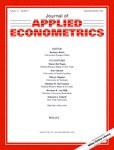
Tommasi, D. and Zhang, L. (2024). Identifying program benefits when participation is misreported Journal of Applied Econometrics, 39(6):1123--1148.
-
Affiliated author
-
Publication year2024
-
JournalJournal of Applied Econometrics
In cases of noncompliance with an assigned treatment, estimates of causal effects typically rely on instrumental variables (IV). However, when participation is also misreported, the IV estimand may become a nonconvex combination of local average treatment effects that fails to satisfy even a minimal condition for being causal. The aim of our paper is to generalize the MR-LATE approach. This is an alternative IV estimand that is more robust in cases of noncompliance and nondifferential misclassification of the treatment variable. Our generalization is threefold: First, we incorporate discrete and multiple-discrete instrument(s); second, we consider the use of instrument(s) under a weaker, partial monotonicity condition; third, we provide a general inferential procedure. Under relatively stringent assumptions, MR-LATE is either identical to the IV estimand or less biased than the naïve IV estimand. Under less stringent assumptions, the MR-LATE estimand can identify the sign of the IV estimand. We conclude with the use of a dedicated Stata command, ivreg2m, to assess the return on education in the United Kingdom.